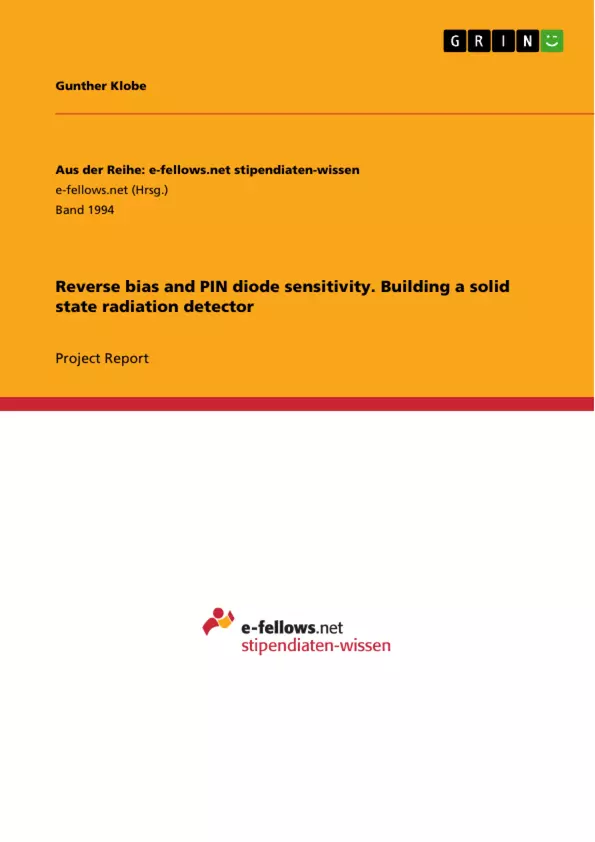This is a report on a research internship at the University of Oxford in the summer of 2014, which describes the final experimental steps in preparing a prototype of a solid state radiation detector based on a PIN diode. This device has multiple possible applications, e.g. it can be used to monitor cosmic radiation and space weather, which is a topic of great interest for space agencies, satellite networks, and insurance companies. The project was a success and the prototype was ready for a test flight in the end.
A prototype of a solid state radiation detector based on a PIN diode has been developed to the point where it was ready for a test flight on a weather balloon. This device is intended to be used to monitor secondary cosmic radiation and may have the potential to be produced commercially since space weather is an issue of growing importance concerning the economy and technology of modern civilisation. Some of the most crucial experimental work in preparation for the test flight is discussed in this report. One important question was what reverse bias should be applied to the PIN diode. As a result, it was found that the detector’s sensitivity increases with increasing reverse bias until it reaches a saturation value at ∼25V. Another concern was that the prototype may not be robust against temperature differences. This concern could be ruled out to a certain extent.
Inhaltsverzeichnis (Table of Contents)
- Introduction
- Motivation
- Small Radiation Detector set-up
- Laboratory testing
- Finding the optimal reverse bias voltage
- Introduction
- Experiment
- Results and data analysis
- Interpretation and conclusion
- Temperature dependence of parcel sensitivity
- Introduction
- Experimental set-up
- Result and conclusion
- Finding the optimal reverse bias voltage
- Conclusion
Zielsetzung und Themenschwerpunkte (Objectives and Key Themes)
This report documents the development and laboratory testing of a prototype solid state radiation detector designed to monitor secondary cosmic radiation. The detector, built with a PIN diode, was developed to the point where it was ready for a test flight on a weather balloon. This work focuses on the crucial experimental steps leading to the test flight.
- Determining the optimal reverse bias voltage for the PIN diode.
- Assessing the detector's sensitivity to temperature variations.
- Investigating the potential of the detector for commercial production, given the growing importance of space weather monitoring.
- Comparing the advantages of a solid state detector to other methods for ionisation measurements, such as ionisation chambers and Geiger counters.
- Understanding the role of cosmic radiation in the atmosphere and its impact on space weather.
Zusammenfassung der Kapitel (Chapter Summaries)
- Introduction: The report introduces the project and its objective, which is to develop a solid state detector for measuring secondary cosmic radiation. This detector was designed for a test flight on a weather balloon.
- Motivation: This chapter discusses the importance of understanding cosmic radiation and space weather for the safety of satellites and other spacecrafts. It compares the strengths and limitations of different technologies used for ionisation measurements, highlighting the advantages of a solid state detector in this context.
- Small Radiation Detector set-up: This chapter details the design of the detector, focusing on the PIN diode and the shielding used to minimize noise from lower energy radiation.
- Laboratory testing: This chapter presents the results of laboratory tests conducted to optimize the detector's performance. This includes:
- Finding the optimal reverse bias voltage: This section describes the experiment to determine the optimal reverse bias voltage for the PIN diode, demonstrating that sensitivity increases with increasing reverse bias up to a saturation value at ~25V.
- Temperature dependence of parcel sensitivity: This section discusses the experimental set-up and results related to the detector's temperature sensitivity, indicating that the prototype is relatively robust against temperature variations.
Schlüsselwörter (Keywords)
The primary keywords and concepts associated with this report are: solid state radiation detector, PIN diode, secondary cosmic radiation, space weather, reverse bias voltage, temperature dependence, ionisation measurement, atmospheric ionisation, weather balloon, sensitivity, energy discrimination.
- Quote paper
- Gunther Klobe (Author), 2014, Reverse bias and PIN diode sensitivity. Building a solid state radiation detector, Munich, GRIN Verlag, https://www.hausarbeiten.de/document/335305


